A BYD C9 electric coach is being trialled at the National University of Singapore (NUS) in support of the CDG-NUS Living Lab, a research collaboration between NUS and ComfortDelGro.
The bus is registered as PC8313P and made its debut on 19 July 2021, operating on Service A1. It is expected to be deployed on various Internal Shuttle Bus (ISB) routes as part of its trial.
Background
The CDG-NUS Smart & Sustainable Mobility Living Lab (or simply CDG-NUS Living Lab) is a new collaboration between the National University of Singapore (NUS) and ComfortDelGro that focuses on Integrated Urban Mobility, Smart and Intelligent Mobility Technologies. The electric bus trial was intended to generate mobility-related data and useful insights on electric vehicle operations on campus, with a future goal of electrifying the Internal Shuttle Bus (ISB) fleet.
The bus made its debut on 19 July 2021, operating on Service A1. The start of trials coincided with the launch of the revamped ISB network, which saw the amendment of many ISB routes. As part of NUS’ safe management measures amid COVID-19, only NUS students and staff are permitted to ride the ISB.
The electric bus provides mobility-related data that supports various research projects under the CDG-NUS Living Lab. The trial also provides NUS’ Office of Campus Amenities (OCA)—which oversees the ISB network—with useful insights about electric vehicle operations as OCA looks to electrify the ISB fleet in future.
The Bus
See Also: Electric Buses in Singapore
The BYD C9 is an electric coach manufactured by BYD Auto in China. The bus is equipped with a 324kWh lithium iron phosphate battery and touts a range of 250 km under urban road conditions. The bus allocated to the trial is registered PC8313P, and bears an advertising wrap promoting the CDG-NUS Living Lab.
As of July 2021, there are two known BYD C9 buses registered in Singapore: PC6284C and PC8313P. Both buses are registered to HDT Singapore Holding Pte Ltd.
Operations
The existing NUS ISB fleet is entirely comprised of low-floor or low-entry buses (Volvo B9L / Scania K230UB) to facilitate quick and easy passenger boarding and alighting, and allow for wheelchair accessibility. The BYD C9, being a high-floor coach, is not wheelchair-accessible and takes longer for passenger boarding and alighting. The NUS Office of Campus Amenities (OCA) has also stated that it did not plan to replace the ISB fleet with electric coaches, and would only consider wheelchair-accessible buses.
PC8313P operates outside the schedule of the regular NUS ISB fleet, i.e. it does not substitute existing scheduled departures performed by normal ISB buses. It also does not show up on the NUS NextBus mobile application. The bus driver was also observed to be recording the start trip mileage and battery state of charge before the start of every trip.
Laminated route signs on the front, side and rear indicate the bus service number.
EDS / PIS retrofit
The trial bus PC8313P was retrofitted with Electronic Display Signage (EDS) in September 2021 as documented by The ISB Man. The Kabym-branded EDS units, installed on the front, side and rear, are similar to those installed on the existing Volvo B9L fleet.
For the interior, a small LED panel was installed as a Passenger Information System (PIS), displaying the same “next stop” and “arriving” information as other ISBs, and paired with next-stop announcements. EDS, PIS, stop-reporting and location features are delivered via the Kabym AL-K80 multifunction terminal, which was added to the dashboard.
Post-trial
From 1 August 2022, PC8313P commenced regular ISB operations on Service BTC, as documented by The ISB Man.
with a partially-restickered livery that replaces the ‘CDG-NUS Living Lab’ with the BUS and ComfortDelGro Bus logo.
Gallery:
Video:
See Also:
- Electric Buses in Singapore | Land Transport Guru
- NUS Internal Shuttle Bus | Land Transport Guru
- First Look in Pictures: BYD C9 – The ISB Man (home.blog)

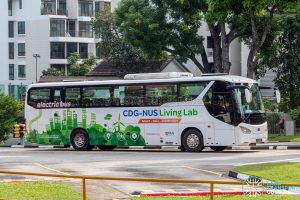
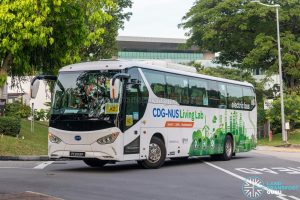

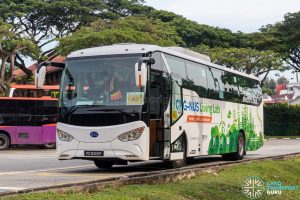
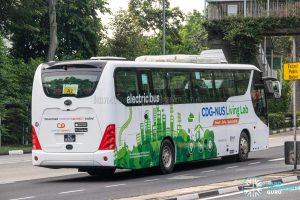
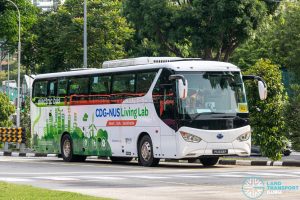
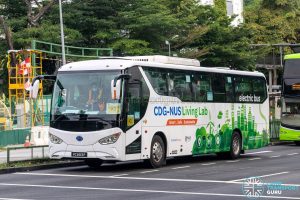
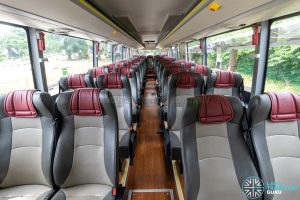
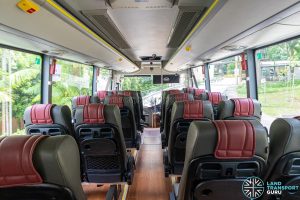
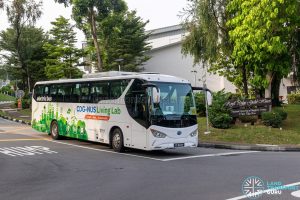
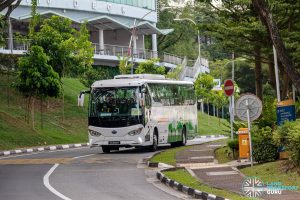
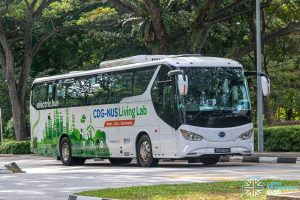
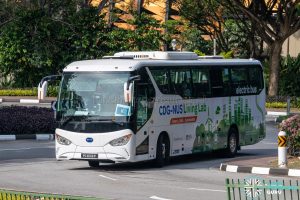
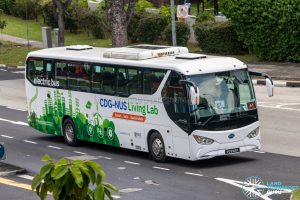

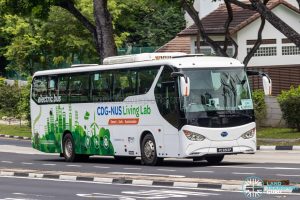


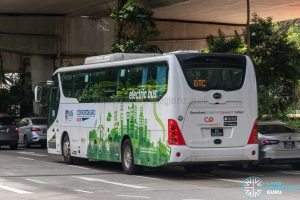

Both NTU and NUS ISB only allow their respective staff and students to ride their ISB.